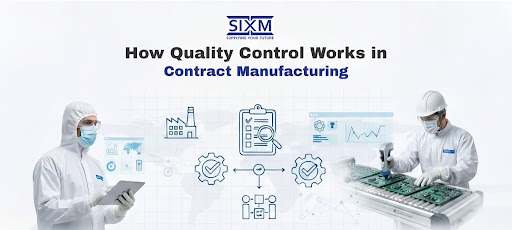
Contract manufacturing (CM) allows companies to expand production capacity and stay flexible without the heavy investment of operating their own facilities. However, the true success of this model relies on one critical element: quality control (QC). Even the most innovative product or advanced production line can fail if quality standards are not consistently met. Weak QC can compromise brand reputation, drive up costs through rework or recalls, and damage customer trust, turning opportunity into risk.
This guide explores how quality control works in contract manufacturing, from setup and process control to inspection, compliance, and continuous improvement.
What Is Quality Control in Contract Manufacturing?
In a contract manufacturing setup, a third-party factory produces goods to a client’s specifications. The brand or original equipment manufacturer (OEM) provides design files, materials, and standards, while the contract manufacturer handles production, assembly, and sometimes packaging or logistics.
Quality control (QC) ensures that every product coming off the production line meets the agreed specifications, safety requirements, and performance standards. It’s not just a one-time check; it’s a continuous process that spans planning, production, testing, and post-production evaluation.
Why Quality Control Is Critical in Contract Manufacturing
Without robust QC, contract manufacturing relationships can quickly fail. Common risks include:
- Inconsistent product quality leading to customer complaints or recalls.
- Hidden defects that escape visual inspection and surface later in the field.
- Regulatory non-compliance, especially in industries like electronics, medical devices, and automotive.
- Rework and scrap costs, which reduce profitability.
- Brand damage due to poor end-user experience.
For global buyers, especially those working across borders, QC is the foundation of trust. When executed well, it ensures product consistency, protects IP, and strengthens long-term supplier relationships.
The Three Pillars of Quality Control
In contract manufacturing, quality control typically relies on three key pillars:
- Quality Planning – defining what “good” looks like before production begins.
- In-Process Control – monitoring and verifying quality during production.
- Final Inspection & Validation – confirming that finished goods meet all requirements.
Let’s look at how each of these works in practice.
1. Quality Planning
Before production starts, both the OEM and CM must align on clear, measurable quality standards. This stage involves documentation, testing criteria, and setting up checkpoints.
Key Components of Quality Planning
- Specifications and Drawings: The buyer provides technical drawings, bill of materials (BOM), and product specs.
- Critical-to-Quality (CTQ) Parameters: These define essential performance attributes that cannot be compromised.
- Sample and Prototype Approval: First articles or prototypes are inspected and validated against the standard.
- Control Plan: Outlines how quality will be measured, what instruments will be used, and how often inspections occur.
- Supplier and Sub-supplier Qualification: Ensures upstream vendors meet material and component standards.
Why It Matters
Strong quality planning prevents ambiguity and ensures both sides agree on tolerances, test methods, and acceptance levels.
2. In-Process Quality Control
Once production begins, quality must be built into every step, not inspected at the end.
In-Process QC Techniques
- Incoming Material Inspection (IQC): Verifies that raw materials and components meet specifications before entering production.
- Process Control (PQC): Monitors key process parameters such as temperature, pressure, torque, or alignment to ensure consistency.
- Statistical Process Control (SPC): Uses data-driven analysis to detect variation early and prevent defects.
- Operator Self-Checks: Workers perform checks at their stations to identify and correct issues in real time.
- First Article Inspection (FAI): The first output of each batch is tested thoroughly before full production proceeds.
Tools and Metrics Used
- Check sheets and inspection logs for real-time data collection.
- Cp and Cpk indices for process capability analysis.
- Gauge R&R studies to validate measurement systems.
In-process QC ensures that defects are caught at the source, reducing waste and rework downstream.
3. Final Inspection and Validation
After production, finished goods go through final quality checks before shipment.
Common Final Inspection Methods
- Visual Inspection: Detects cosmetic or assembly defects.
- Functional Testing: Ensures the product performs as intended (e.g., electronics, appliances).
- Dimensional Verification: Uses calipers, micrometers, or coordinate measuring machines (CMMs).
- Sampling Based on AQL (Acceptable Quality Limit): Determines how many units to inspect and the pass/fail criteria.
Documentation and Release
All inspections are documented in final inspection reports, which form the basis for product release. If defects exceed limits, the lot is held, reworked, or rejected.
How a Quality Management System (QMS) Becomes the Backbone of Contract Manufacturing
A Quality Management System (QMS) is the backbone of QC in contract manufacturing. It ensures that every process, document, and inspection aligns with defined standards.
Essential QMS Components
- Standard Operating Procedures (SOPs): Define how tasks are performed.
- Work Instructions: Detail inspection methods and tools.
- Non-Conformance and Corrective Action Systems (NC/CAPA): Record, analyze, and fix recurring issues.
- Training Programs: Ensure staff are qualified to perform inspections.
Certification Standards
Reputable CMs are certified to international standards such as:
- ISO 9001: General quality management systems.
- ISO 13485: Medical device manufacturing.
- IATF 16949: Automotive quality management.
- AS9100: Aerospace manufacturing.
Certification demonstrates consistent process control and continuous improvement commitment.
How the Buyer Plays a Key Role in Quality Control
Buyers play an active role in defining, monitoring, and auditing QC.
Key Buyer Responsibilities
- Pre-Audit Assessments: Verify factory certifications, equipment, and QC teams before engagement.
- Defining Quality Metrics: Agree on AQL levels, test methods, and failure thresholds.
- On-Site Audits: Periodically review operations, process control, and compliance.
- Performance Dashboards: Track supplier KPIs such as on-time delivery, PPM (parts per million), and defect rates.
- Joint Corrective Action Reviews: Collaborate to address recurring issues.
Partnership-driven quality management ensures alignment between both parties’ expectations.
The right quality control partner is just as important as selecting your manufacturer. Explore How to Choose the Right QC Partner for Garment Sourcing in Mexico to ensure consistent quality and compliance.
How Quality Issues Are Managed
Even with strong systems, quality issues can arise. How they’re handled defines the success of the relationship.
The Quality Issue Lifecycle
- Detection: The issue is found through testing or customer feedback.
- Containment: Affected products are quarantined to prevent further shipment.
- Root Cause Analysis (RCA): Teams investigate using tools like 5 Whys or Fishbone Diagrams.
- Corrective Action: The process is changed to prevent recurrence.
- Verification: Follow-up checks confirm effectiveness.
Key Tools
- Failure Mode and Effects Analysis (FMEA): Identifies potential failure points early.
- 8D Reports: Structured documentation for problem-solving and accountability.
How Is Technology Transforming Quality Control in Contract Manufacturing?
Modern contract manufacturers increasingly leverage digital tools to enhance QC accuracy and traceability.
Smart QC Solutions
- Digital Quality Dashboards: Real-time monitoring of defects, yields, and inspection results.
- AI-Based Visual Inspection: Uses machine learning to detect surface or assembly flaws faster than manual inspection.
- IoT Sensors: Capture live process data to ensure consistency.
- Blockchain Traceability: Records supply chain and QC data immutably for audit trails.
These tools reduce subjectivity, improve speed, and enhance visibility across global supply networks.
What Are the Key Compliance and Regulatory Requirements in Contract Manufacturing?
Industries such as medical, aerospace, automotive, and electronics have strict compliance frameworks.
Key Regulatory Benchmarks
- FDA CFR 820: U.S. regulations for medical devices.
- RoHS and REACH: Environmental standards for electronics and materials.
- CE/UL Certifications: Product safety compliance for exports.
- ISO/ASTM Standards: For material and process control in specialized sectors.
Contract manufacturers must maintain traceable documentation and audit readiness at all times.
To strengthen your quality strategy even further, explore our guide on Effective Quality Control Methods to Improve Product and Service Excellence and learn practical ways to enhance consistency, reliability, and customer satisfaction.
How Continuous Improvement Drives Quality Beyond Compliance
True quality excellence goes beyond inspection; it’s about continuous improvement.
Strategies for Continuous Improvement
- Lean Manufacturing & Six Sigma: Reduce process variation and waste.
- Kaizen Events: Encourage small, incremental improvements.
- Supplier Development Programs: Help sub-suppliers meet quality expectations.
- Performance Benchmarking: Compare plant or supplier performance globally.
Manufacturers that embrace improvement culture achieve higher yields, faster time-to-market, and stronger customer satisfaction.
What Are the Most Common Quality Control Challenges in Contract Manufacturing?
Even the best systems face obstacles. Some of the most frequent challenges include:
- Cultural and language barriers causing miscommunication.
- Incomplete documentation or unclear specifications.
- Weak supplier quality programs at sub-tier vendors.
- Cost vs. quality pressure from buyers.
- Inadequate data visibility in multi-site production.
Proactive training, clear communication, and robust audits help mitigate these risks.
How SIXM Ensures Quality in Contract Manufacturing
At SIXM, we believe quality isn’t just a requirement; it’s the foundation of lasting success.
Our Sourcing & Procurement Services are built on deep supplier insight, data-driven evaluation, and consistent field oversight. We help global companies:
- Qualify contract manufacturers through rigorous audits.
- Develop and implement control plans aligned with ISO standards.
- Oversee in-process and pre-shipment inspections.
- Manage supplier KPIs for continuous improvement.
- Ensure full traceability across your manufacturing ecosystem.
With SIXM as your partner, you gain transparency, reliability, and control, ensuring your contract manufacturing relationships deliver lasting value.
SIXM: Empowering Global Manufacturers Through Quality Excellence
Quality control is the foundation of successful contract manufacturing. Across global operations, including Contract Manufacturing in Mexico, quality control ensures that every product consistently meets design intent, regulatory standards, and customer expectations.
When quality is embedded into every phase, from planning and production to inspection and improvement, it transforms contract manufacturing from a cost-saving measure into a driver of long-term value and trust.
At SIXM, we help global manufacturers build transparent, reliable, and quality-driven partnerships that elevate performance, strengthen compliance, and fuel sustainable growth.

